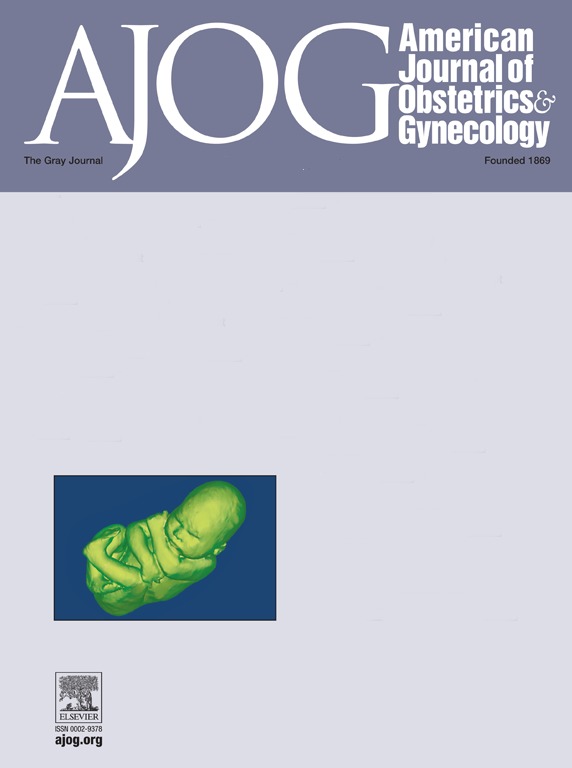Formation of the placental membranes and pathophysiological origin of associated Great Obstetrical Syndromes.
IF 8.4
1区 医学
Q1 OBSTETRICS & GYNECOLOGY
引用次数: 0
Abstract
Formation of the smooth membranes is an essential phase of human placentation to allow safe rupture of the chorionic sac and birth of the fetus without damaging the placenta. The membranes form through regression of two-thirds of the villi that cover the early gestational sac shortly after implantation. Regression is associated with locally high levels of oxidative stress secondary to partial onset of the maternal arterial circulation to the placenta. Onset starts preferentially in the peripheral zone from ∼6-8 weeks of gestation, reflecting the lesser extent of plugging of maternal spiral arteries by endovascular trophoblast in this region. Plugging is part of the arterial remodeling essential to control adequate and even perfusion of the placenta. As the chorionic sac expands extensive necrosis occurs in the overlying decidua capsularis, which consequently makes no contribution to the mature membranes. Once the sac fuses with the decidua parietalis lining the opposite wall of the uterus, at around 16 weeks of gestation, the cytotrophoblast cells of the chorionic epithelium proliferate and form a stratified epithelium with features reminiscent of the skin barrier. A sharp demarcation exists between this epithelium and the cells of the decidua parietalis in the mature membranes, with no evidence of trophoblast migration. Pre-term premature rupture of the membranes and pre-term labor are associated with deficient remodeling of the spiral arteries that is mediated by extravillous trophoblast derived from the cytotrophoblastic shell. The resultant placental malperfusion causes maternal and placental oxidative stress, as in the other Great Obstetrical Syndromes (GOS), causing release of pro-inflammatory cytokines and stimulating uterine contractility. Deficient remodeling is also likely a proxy marker for poor development of the cytotrophoblastic shell. The shell anchors the gestational sac at the maternal-placental interface post-implantation, and weakness of this interface predisposes to subchorionic hemorrhage. Hemorrhages that abut the membranes may induce local inflammation, senescence and weakening. Ensuring normal development of the cytotrophoblastic shell is therefore essential to prevent the GOS. At this stage of pregnancy, placental development is supported by histotrophic nutrition from the decidua. Hence, optimising endometrial function prior to conception should become a health-care priority.胎盘膜的形成和相关大产科综合征的病理生理起源。
平滑膜的形成是人类胎盘的一个重要阶段,它允许绒毛膜囊的安全破裂和胎儿的出生而不损害胎盘。在胚胎着床后不久,覆盖在早期妊娠囊上的三分之二的绒毛消退形成膜。退化与局部高水平的氧化应激有关,继发于母体胎盘动脉循环的部分开始。妊娠6-8周的外周区优先发病,反映了母体螺旋动脉在该区域被血管内滋养细胞堵塞的程度较小。堵塞是动脉重塑的一部分,对控制胎盘充足和均匀的灌注至关重要。随着绒毛膜囊的扩张,其上的荚膜蜕膜发生广泛的坏死,因此对成熟膜没有贡献。在妊娠16周左右,一旦囊与子宫对面壁的蜕膜壁融合,绒毛膜上皮的细胞滋养细胞增殖并形成层状上皮,其特征与皮肤屏障相似。在成熟膜中,该上皮和顶蜕膜细胞之间存在明显的分界,没有滋养细胞迁移的证据。早产儿胎膜早破和早产与螺旋动脉重构缺陷有关,螺旋动脉重构缺陷是由细胞滋养层壳衍生的外滋养细胞介导的。由此产生的胎盘灌注不良引起母体和胎盘氧化应激,与其他大产科综合征(GOS)一样,引起促炎细胞因子的释放并刺激子宫收缩。重塑缺陷也可能是细胞滋养层外壳发育不良的代理标记。胚胎着床后,胎壳将妊娠囊固定在母体-胎盘界面,而该界面的薄弱易导致绒毛膜下出血。靠近细胞膜的出血可引起局部炎症、衰老和衰弱。因此,确保细胞滋养层外壳的正常发育对于预防GOS至关重要。在怀孕的这个阶段,胎盘的发育是由蜕膜的组织营养支持的。因此,在受孕前优化子宫内膜功能应成为保健的优先事项。
本文章由计算机程序翻译,如有差异,请以英文原文为准。
求助全文
约1分钟内获得全文
求助全文
来源期刊
CiteScore
15.90
自引率
7.10%
发文量
2237
审稿时长
47 days
期刊介绍:
The American Journal of Obstetrics and Gynecology, known as "The Gray Journal," covers the entire spectrum of Obstetrics and Gynecology. It aims to publish original research (clinical and translational), reviews, opinions, video clips, podcasts, and interviews that contribute to understanding health and disease and have the potential to impact the practice of women's healthcare.
Focus Areas:
Diagnosis, Treatment, Prediction, and Prevention: The journal focuses on research related to the diagnosis, treatment, prediction, and prevention of obstetrical and gynecological disorders.
Biology of Reproduction: AJOG publishes work on the biology of reproduction, including studies on reproductive physiology and mechanisms of obstetrical and gynecological diseases.
Content Types:
Original Research: Clinical and translational research articles.
Reviews: Comprehensive reviews providing insights into various aspects of obstetrics and gynecology.
Opinions: Perspectives and opinions on important topics in the field.
Multimedia Content: Video clips, podcasts, and interviews.
Peer Review Process:
All submissions undergo a rigorous peer review process to ensure quality and relevance to the field of obstetrics and gynecology.

 求助内容:
求助内容: 应助结果提醒方式:
应助结果提醒方式:


